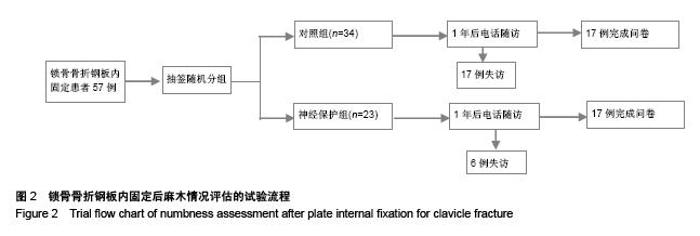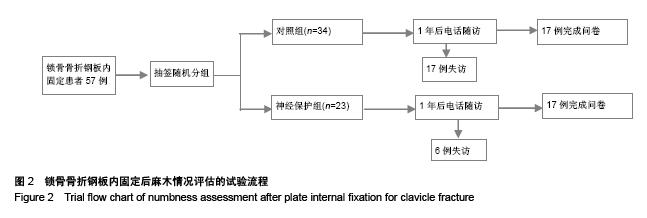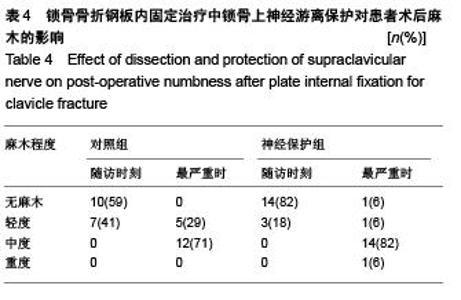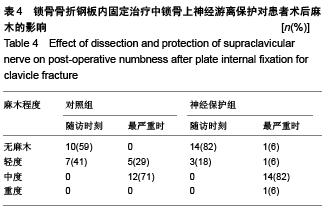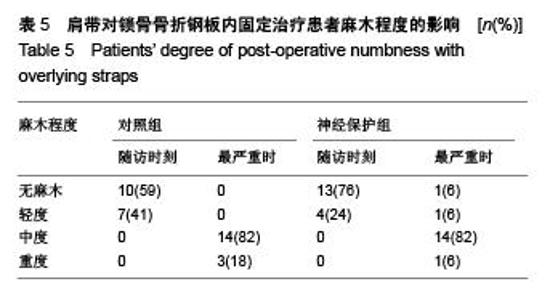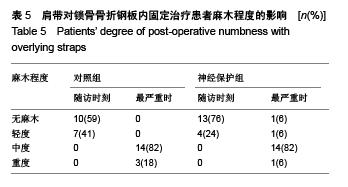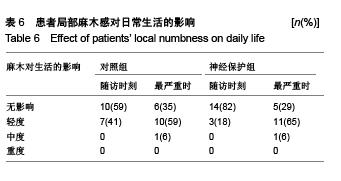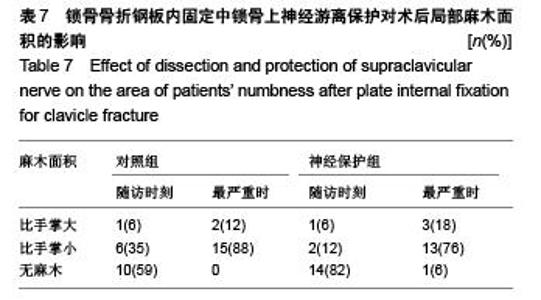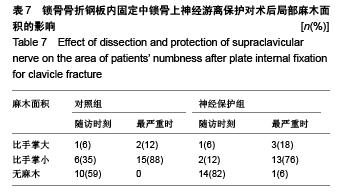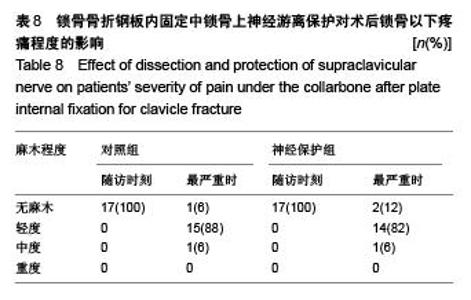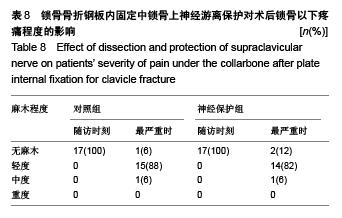Chinese Journal of Tissue Engineering Research ›› 2015, Vol. 19 ›› Issue (53): 8573-8578.doi: 10.3969/j.issn.2095-4344.2015.53.008
Previous Articles Next Articles
Supraclavicular nerve dissection and protection in plate internal fixation of clavicle fracture
Xu Rui-da1,2, Li Xiao-miao1, 2, Cheng Guang-qi1, 2, Han Xiao-feng1, 2
- 1Department of Orthopedics, Southern Division, Ren Ji Hospital, School of Medicine, Shanghai Jiao Tong University, Shanghai 201112, China; 2Department of Orthopedics, Ren Ji Hospital, School of Medicine, Shanghai Jiao Tong University, Shanghai 200127, China
-
Received:2015-11-18Online:2015-12-24Published:2015-12-24 -
Contact:Han Xiao-feng, Master, Attending physician, Department of Orthopedics, Southern Division, Ren Ji Hospital, School of Medicine, Shanghai Jiao Tong University, Shanghai 201112, China; Department of Orthopedics, Ren Ji Hospital, School of Medicine, Shanghai Jiao Tong University, Shanghai 200127, China -
About author:Xu Rui-da, Master, Physician, Department of Orthopedics, Southern Division, Ren Ji Hospital, School of Medicine, Shanghai Jiao Tong University, Shanghai 201112, China; Department of Orthopedics, Ren Ji Hospital, School of Medicine, Shanghai Jiao Tong University, Shanghai 200127, China -
Supported by:the Shanghai Young Physician Training Program in 2012
CLC Number:
Cite this article
Xu Rui-da, Li Xiao-miao, Cheng Guang-qi, Han Xiao-feng. Supraclavicular nerve dissection and protection in plate internal fixation of clavicle fracture[J]. Chinese Journal of Tissue Engineering Research, 2015, 19(53): 8573-8578.
share this article
| [1] Christensen TJ, Horwitz DS, Kubiak EN. Natural history of anterior chest wall numbness after plating of clavicle fractures: educating patients. J Orthop Trauma. 2014;28(11):642-647. [2] Beirer M, Postl L, Crönlein M, et al. Does a minimal invasive approach reduce anterior chest wall numbness and postoperative pain in plate fixation of clavicle fractures? BMC Musculoskelet Disord. 2015;16:128. [3] Robinson CM, Goudie EB, Murray IR, et al. Open reduction and plate fixation versus nonoperative treatment for displaced midshaft clavicular fractures: a multicenter, randomized, controlled trial. J Bone Joint Surg Am. 2013;95(17): 1576- 1584.[4] Canadian Orthopaedic Trauma Society. Nonoperative treatment compared with plate fixation of displaced midshaft clavicular fractures. A multicenter, randomized clinical trial. J Bone Joint Surg Am. 2007;89(1):1-10.[5] Shen WJ, Liu TJ, Shen YS. Plate fixation of fresh displaced midshaft clavicle fractures. Injury. 1999;30(7):497-500.[6] Wang L, Ang M, Lee KT, et al. Cutaneous hypoesthesia following plate fixation in clavicle fractures. Indian J Orthop. 2014;48(1):10-13. [7] 王冕,胡佰文,李纯志.医源性锁骨上神经损伤[J].实用骨科杂志, 2005,11(1):57-58.[8] 孙锋,舒莉莉,高向勇.保护锁骨上神经的锁骨骨折内固定[J].中国修复重建外科杂志,2009,(12):1465.[9] 沈军,刘遵勇,余迎浩,等.切开复位内固定术中保护锁骨上神经治疗锁骨骨折[J].中国中医骨伤科杂志,2014,22(10):25-26.[10] 胡寿勇,石华峰,谢辉,等.保护锁骨上神经行锁骨骨折切开复位内固定术[J].中华手外科杂志,2015,31(3):235-235.[11] Nathe T, Tseng S, Yoo B. The anatomy of the supraclavicular nerve during surgical approach to the clavicular shaft. Clin Orthop Relat Res. 2011;469(3):890-894. [12] 柏士平,张守忠.锁骨上神经营养血管皮瓣的应用解剖[J].中国使用美容整形外科杂志,2006,17(3):186-188.[13] Wang K, Dowrick A, Choi J, et al. Post-operative numbness and patient satisfaction following plate fixation of clavicular fractures. Injury. 2010;41(10):1002-1005. [14] Erdo?an M, Desteli EE, Ímren Y, et al. Supraclavicular neuropathy after surgical treatment of clavicular fractures: comparison of two incisions. Acta Chir Orthop Traumatol Cech. 2014;81(6):387-391.[15] 郑亦静,洪建军,程涛,等.微创经皮锁定钢板与切开复位重建钢板内固定在治疗锁骨骨折中的疗效比较[J].中华手外科杂志,2013, 29(4):225-227.[16] 王秀会,王喆,夏胜利,等.锁定钢板经皮治疗锁骨中段骨折的疗效评价[J].中华手外科杂志,2012,28(6):380-381. |
| [1] | Chen Ziyang, Pu Rui, Deng Shuang, Yuan Lingyan. Regulatory effect of exosomes on exercise-mediated insulin resistance diseases [J]. Chinese Journal of Tissue Engineering Research, 2021, 25(25): 4089-4094. |
| [2] | Chen Yang, Huang Denggao, Gao Yuanhui, Wang Shunlan, Cao Hui, Zheng Linlin, He Haowei, Luo Siqin, Xiao Jingchuan, Zhang Yingai, Zhang Shufang. Low-intensity pulsed ultrasound promotes the proliferation and adhesion of human adipose-derived mesenchymal stem cells [J]. Chinese Journal of Tissue Engineering Research, 2021, 25(25): 3949-3955. |
| [3] | Yang Junhui, Luo Jinli, Yuan Xiaoping. Effects of human growth hormone on proliferation and osteogenic differentiation of human periodontal ligament stem cells [J]. Chinese Journal of Tissue Engineering Research, 2021, 25(25): 3956-3961. |
| [4] | Sun Jianwei, Yang Xinming, Zhang Ying. Effect of montelukast combined with bone marrow mesenchymal stem cell transplantation on spinal cord injury in rat models [J]. Chinese Journal of Tissue Engineering Research, 2021, 25(25): 3962-3969. |
| [5] | Gao Shan, Huang Dongjing, Hong Haiman, Jia Jingqiao, Meng Fei. Comparison on the curative effect of human placenta-derived mesenchymal stem cells and induced islet-like cells in gestational diabetes mellitus rats [J]. Chinese Journal of Tissue Engineering Research, 2021, 25(25): 3981-3987. |
| [6] | Hao Xiaona, Zhang Yingjie, Li Yuyun, Xu Tao. Bone marrow mesenchymal stem cells overexpressing prolyl oligopeptidase on the repair of liver fibrosis in rat models [J]. Chinese Journal of Tissue Engineering Research, 2021, 25(25): 3988-3993. |
| [7] | Liu Jianyou, Jia Zhongwei, Niu Jiawei, Cao Xinjie, Zhang Dong, Wei Jie. A new method for measuring the anteversion angle of the femoral neck by constructing the three-dimensional digital model of the femur [J]. Chinese Journal of Tissue Engineering Research, 2021, 25(24): 3779-3783. |
| [8] | Meng Lingjie, Qian Hui, Sheng Xiaolei, Lu Jianfeng, Huang Jianping, Qi Liangang, Liu Zongbao. Application of three-dimensional printing technology combined with bone cement in minimally invasive treatment of the collapsed Sanders III type of calcaneal fractures [J]. Chinese Journal of Tissue Engineering Research, 2021, 25(24): 3784-3789. |
| [9] | Qian Xuankun, Huang Hefei, Wu Chengcong, Liu Keting, Ou Hua, Zhang Jinpeng, Ren Jing, Wan Jianshan. Computer-assisted navigation combined with minimally invasive transforaminal lumbar interbody fusion for lumbar spondylolisthesis [J]. Chinese Journal of Tissue Engineering Research, 2021, 25(24): 3790-3795. |
| [10] | Hu Jing, Xiang Yang, Ye Chuan, Han Ziji. Three-dimensional printing assisted screw placement and freehand pedicle screw fixation in the treatment of thoracolumbar fractures: 1-year follow-up [J]. Chinese Journal of Tissue Engineering Research, 2021, 25(24): 3804-3809. |
| [11] | Shu Qihang, Liao Yijia, Xue Jingbo, Yan Yiguo, Wang Cheng. Three-dimensional finite element analysis of a new three-dimensional printed porous fusion cage for cervical vertebra [J]. Chinese Journal of Tissue Engineering Research, 2021, 25(24): 3810-3815. |
| [12] | Wang Yihan, Li Yang, Zhang Ling, Zhang Rui, Xu Ruida, Han Xiaofeng, Cheng Guangqi, Wang Weil. Application of three-dimensional visualization technology for digital orthopedics in the reduction and fixation of intertrochanteric fracture [J]. Chinese Journal of Tissue Engineering Research, 2021, 25(24): 3816-3820. |
| [13] | Sun Maji, Wang Qiuan, Zhang Xingchen, Guo Chong, Yuan Feng, Guo Kaijin. Development and biomechanical analysis of a new anterior cervical pedicle screw fixation system [J]. Chinese Journal of Tissue Engineering Research, 2021, 25(24): 3821-3825. |
| [14] | Lin Wang, Wang Yingying, Guo Weizhong, Yuan Cuihua, Xu Shenggui, Zhang Shenshen, Lin Chengshou. Adopting expanded lateral approach to enhance the mechanical stability and knee function for treating posterolateral column fracture of tibial plateau [J]. Chinese Journal of Tissue Engineering Research, 2021, 25(24): 3826-3827. |
| [15] | Zhu Yun, Chen Yu, Qiu Hao, Liu Dun, Jin Guorong, Chen Shimou, Weng Zheng. Finite element analysis for treatment of osteoporotic femoral fracture with far cortical locking screw [J]. Chinese Journal of Tissue Engineering Research, 2021, 25(24): 3832-3837. |
| Viewed | ||||||
|
Full text |
|
|||||
|
Abstract |
|
|||||
